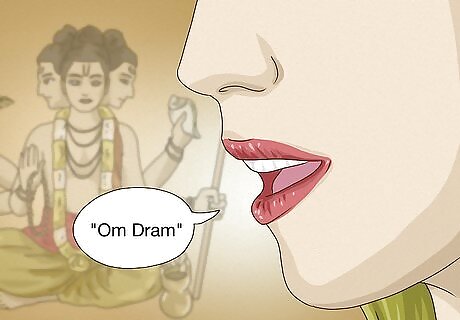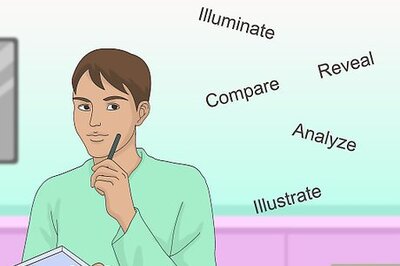
views
- Dattetreya is a Hindu deity said to be an incarnation of the Hindu trinity, which includes the gods Brahma, Shiva, and Vishnu.
- Dattetreya was born, or given to, the sages Atri and Anasuya as a reward for their piety, devotion, and wisdom.
- Dattetreya is often depicted with the 3 heads of the trinity, and 6 hands that each hold a tool of the gods of the trinity.
Who is Dattatreya?

Dattatreya is an ancient Hindu deity. He’s said to be an incarnation of the 3 major gods of the Hindu trinity—Brahma, Shiva, and Vishnu. Some traditions say he’s closely associated with Shiva, the destroyer of evil, while others say he’s an avatar of Vishnu, the supreme god. In many traditions, Dattatreya is said to have overcome worldly affairs like desire, and his presence stays on Earth to grant material desires and to offer guidance to his followers. Dattatreya’s name comes from the words “datta,” meaning “given,” and the name “Atri,” who is Dattatreya’s father. So altogether, his name means “given to Atri.” Dattatreya is mysterious, in that there are many conflicting accounts of his life and status as a god, and these accounts often vary by tradition.
Appearance & Symbolism

Dattatreya is depicted with 3 heads and 6 arms. Each head and set of arms corresponds to one of the gods of the trinity which Dattatreya represents—Brahma, Shiva, and Vishnu. In each hand, he holds one of the trinity’s tools: the conch and wheel (or discus) of Vishnu, the mace and trident of Shiva, and the water pot and begging bowl of Brahma. The conch represents the expansion of consciousness, while the wheel represents time. The mace controls pride, while the trident represents 3 energies within the body. The water pot carries life, while the begging bowl encourages us to give up our vices.
Dattatreya is often accompanied by 4 dogs and a cow. The dogs represent the 4 Vedas, or religious scripts, symbolizing truth and wisdom. The cow is the goddess Kamadhenu, who grants desires. Dattatreya is also often depicted in front of a tree, which is said to be the Audumbara tree, which grants wishes.
Origin & Birth

Dattatreya is the son of Atri and Anasuya. These two were pious and mystical sages in their own right, and Anasuya was said to be particularly chaste and pious among women. Together, the two had 3 sons in total: Dattatreya, Durvasa, and Chandra. Like most teachings about Dattatreya, there are many different versions of his birth story. Some say he was given in reward for Anasuya’s devotion, others say that he was a reward after Anasuya rescued the 3 gods of the trinity.
Vishnu, Brahma, and Shiva wanted to test Anasuya’s piety. In this common version of the story, the 3 gods appeared to Anasuya and asked her to offer them alms immediately, and while naked. Anasuya, being chaste, turned the gods into innocent children before she did as they said, protecting her honor. When the gods’ wives got worried and asked Anasuya to turn them back, Anasuya agreed, and the gods rewarded her with a son in their image, Dattatreya.
Anasuya was rewarded for her charity. In this version of the story, a leper was cursed to die at sunrise, and his wife, Sandili, warded off the curse by causing the sun to never rise. The trinity then visited Anasuya for help, since she was so pious, and Anasuya spoke with Sandili and bartered a deal in which the sun would rise and the leper would not be harmed. As thanks, the trinity offered Anasuya a gift. She requested that each of them be born to her, and she received Dattatreya.
Life & Teachings

Dattatreya taught his followers about a universal consciousness. This concept, also called the “Brahman,” states that every being has inside them a speck of the supreme being. Each being is distracted by the material world, but has the potential to realize their true nature and reunite with the supreme being in a state of truth, consciousness, and bliss. To reunite, each being must become aware that the material world is temporary, and detach themself from it, and also acknowledge that only truth is permanent.
Dattatreya’s teachings are loose and casual. It’s said that following in Dattatreya’s path is simple, and that there are no formal regulations. All Dattatreya requests is 4 things: contemplation, feeding others, maintaining your duties, and to see Dattetreya’s essence and teachings in all beings and while resting.
Dattetreya originated Ashtanga Yoga. It’s said that Dattetreya formulated the “eightfold” path of yoga, and his follower Patanjali recorded it. Ashtanga Yoga involves 8 tenets: Yama, or peacefulness and truthfulness Niyama, or cleanliness and moral discipline Asana, or posture Pranayama, or control of breathing, or “life force” Pratayahara, or control of your senses Dharana, or concentration Dhyana, or meditation Samadhi, or the transcendental state, or unity
Dattatreya identified 24 teachers, or gurus. Many Hindu traditions believe that the sacred is all around us, and we can learn from it if only we recognize it. It’s said that Dattatreya achieved his wisdom through 24 sources that he found all around him, and used these sources, or gurus, in his own teachings. One story says that a king came to visit Dattatreya’s parents and spoke with Dattatreya, who was still a boy. The king was so impressed at his wisdom, despite his young age, that he asked how he came to be so wise, at which Dattatreya explained his 24 gurus.
24 Gurus of Dattatreya

Earth The Earth teaches us to be resolute and firm in the face of those who would “trample” or oppress us, and to flourish and provide for ourselves and others in spite of that. She tells us to remember that our enemies are only acting according to their nature.
Water Water tells us to help others without being proud, and to provide purity and life to whoever wants it. It also tells us to continue to move and to act, and to never become stationary or stagnant.
Fire Fire purifies all that it touches. It also is never corrupted by what it touches, or the material world it consumes. It’s a blaze of truth and teaching, and leaps to life when the moment is right to teach and to purify.
Wind The wind moves through the world unhindered and unattached to material things, but it also acts upon the world as it moves all it touches. We must be free of distraction and able to shift like the wind.
Air The air, or empty space around us, has infinite room to hold everything in the universe, but itself can’t be moved by the material world. Like the air, we should remember to make space for everything and all experiences, but not get attached to them.
Moon The moon changes its appearance and shape but never loses sight of its own essence. Like the moon, we must remember that we’re always changing, but never lose sight of who we are.
Sun The sun nourishes and provides by gathering water and releasing it over creation. Just like the sun, we must gather truth from everywhere we can find it and share freely and without reservations.
Pigeons Pigeons move as flocks, and when one is struck by a hunter, the others try to save it, thus falling prey to the hunter themselves. They remind us that even good actions can be harmful when they come from a place of material attachment.
Python The python is an opportunistic hunter, eating whatever it comes across and feeling full. We, too, must be satisfied with what we encounter and what we are given, and never yearn for more.
Bees The bee is one creature that is involved with material things, gathering pollen from flowers. However, it gathers only what it needs, and gathers without discrimination, just like we ought to gather truth and wisdom from the world around us. It also aids others in doing the same by distributing pollen.
Beekeeper The beekeeper relieves the bees of their burdensome honey, or material wealth. We, too, should strive to help others relieve their own burdens and attain wisdom.
Hawk The hawk hunts, but once it strikes its prey, it is targeted by other predator birds, after which it relinquishes its wealth and moves on. It reminds us that the material world brings only trouble, and happiness is attained through spiritual pursuits.
Ocean The ocean receives water from every river and stream, but never overflows or grows too big for itself. Like the ocean, we must absorb all the hardships of life without forgetting our values.
Moth The moth is fatally drawn by light, giving itself up for the sake of truth. Like the moth, we must overcome our fears and surrender ourselves to knowledge in order to be transformed.
Elephant The elephant is easily trapped by its desire to mate with other elephants, and wily hunters use trapped elephants for labor. It reminds us to mind our desires carefully, or else we, too, may become prey.
Deer The deer is cautious and wary, but still swoons at the sound of the hunter’s melody. It teaches us to stay attentive to information, gossip, and news, but to remain wary of the things we hear and learn, and not to be caught by things that we only want to hear.
Fish The fish’s great downfall is its own desire for food, which causes it to take the fisherman’s bait. It teaches us that if we can control our desires, particularly our desire for food, we can control ourselves, as well.
Reformed prostitute The reformed prostitute realizes the error of her ways and comes to understand that fulfillment is found through spiritual matters, not matters of money or the body.
Child The child is entirely innocent, and therefore lives a happy and blissful life. They ask for only what they need—love and milk—and stop asking when they are full. The child teaches us to take only what we need, and nothing more.
Maiden While the maiden is burdened by the task of feeding her guests, her bangles make an irritable jangle as she prepares the food. She breaks all of them but one to prevent the noise, teaching us that silence is valuable, and company is distracting.
Snake The snake is solitary and a hermit, and avoids humans at any cost. Like the snake, we must turn inward and learn to cherish solitude in order to achieve self-realization.
Arrowsmith The arrowsmith was so absorbed in his business of making superb arrows that he didn’t even notice when the king’s parade passed by his door. Like the arrowsmith, we must concentrate on our work to achieve wisdom.
Spider The spider retreats to its web in times of danger, but in its haste trips and is caught in that very same web. Spiders teach us that the safe havens we build for ourselves are only traps, and that true safety comes from being detached from worldly matters.
Caterpillar The caterpillar that is captured by the bird is so enraptured by the bird’s song that it becomes like a bird itself, despite the danger. We, too, ought to be absorbed by knowledge, truth, and the supreme, so that we become like the supreme ourselves.
Mantras

Basic mantra It’s often said that Dattatreya’s guru mantram, or sacred sound, is “dram.” This consists of “da,” which means “to donate,” and “ra,” which relates to fire, or the burning away of ignorance and impurity. Repeating “Om Dram” is said to bring Dattetreya’s presence and his teachings into yourself.
Healing mantra To say a mantra for healing, recite and repeat the following: “Jataadharam Paandurangam / Shulahasta Krupaanidhim / Sarvaroga Haram Devam / Dattatreyam Aham Bhaje.” This means: “With matted locks, the One who is Lord Vishnu / Who bears a trident in hand and is an Ocean of Mercy / The Divine Remover of all maladies/ Dattatreya, I worship You.”

Freedom mantra To say a mantra for personal and spiritual liberation, recite: “Om Hreem Draam Shree Gurudeva Datta / Digambara Digambara Dattatreyaya Namaha,” which means, “I Deeply Honour Dattatreya, God, and Guru, Principle of Origin and Manifestation, Whose Dimensions are Infinite like the Directions.”


















Comments
0 comment